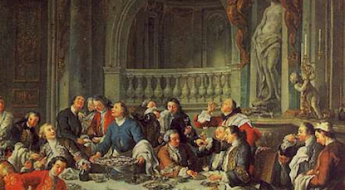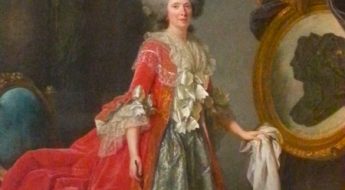A Childhood at Versailles consists of the first 5 chapters of the memoirs of Mme de Boigne (1781-1866), née Adèle d’Osmond, who was a French salon hostess and writer. She was born in the Château de Versailles and lived at the court of Louis XVI and Marie-Antoinette until her family fled to England during the Revolution. Later in her long life, she married a rich soldier of fortune 30 years her senior, hosted a brilliant salon in Paris, and became an intimate of the last French queen, Marie-Amélie, consort of King Louis Philippe (r. 1830-1848). Childless herself, Mme de Boigne addressed her memoirs to her nephew. The memoirs were not published until 1907, under the title Récits d’une tante, or An Aunt’s Tales. They’ve never been published in English, as far as I know, so I’ve decided to translate the first 5 chapters, the ones that take place mainly at Versailles, and post them here on this blog for interested readers to enjoy for free.
The chapters are quite lengthy, so I’ve broken each one into several parts. In Part 1.3 (see below), Mme de Boigne recalls the sharp class distinctions among the courtiers residing at Versailles on the eve of the Revolution. Hint: Not everyone who lived at Court was a courtier.
A CHILDHOOD AT VERSAILLES, PART 1.3
It was soon after my parents settled into Versailles that I came into the world. My mother had already been delivered of a still-born infant, so I was welcomed with transports of joy and pardoned for being a girl. I was not swaddled, as was still the custom, but dressed in the English manner and nursed by my mother in the midst of Versailles. I promptly became the plaything of the princes and the court, all the more since I was very well-behaved, and also since children in those days were as rare a species in a drawing room as they are common and tyrannical today.
My father fashioned a routine for himself and ended up reconciling himself with Court life.
Saturday evening and Sunday were very much Court days, in all their state. Crowds abounded. All the ministers, and all of what were called the charges, which is to say the Captain of the Guards, the First Gentleman of the Bedchamber, the Grand equerry, the Governess of the Children of France, and the Superintendent of the Queen’s Household, gave dinners on the Saturday and lunches on the Sunday. Those arriving from Paris were invited to them. People who had houses were nearly crowded out of them.
There was also a common table where one and all could eat at the King’s expense, but no man of the Court would have wanted to appear there. And if by some chance one had not been invited to one of the houses I have mentioned, one would rather have eaten a chicken at an inn than go to sit at that table, which was regarded as second-rate, although originally it had been instituted for the Court lords, and until about the middle of the reign of Louis XV there was no difficulty about going there. In those times, however, the great officers of the Court did not keep their own households and dined at the common table. Now the seats around it were occupied by holders of positions that constituted a kind of second rank and were classed as positions from which it was impossible to break out as long as one was at Court: they were those who took orders from persons who did not hold the title Grand. In this way, an ordinary gentleman of the Bedchamber, who took orders from the First Gentleman, was very subaltern, while the First Equerry, who took orders from the Grand Equerry, was a man of the Court; however, the equerries who took orders from him fell into the subaltern class, which drew a line of demarcation that could never be crossed. There was really no means of crossing this line, to the point that M de Grailly, being merely an equerry, found that all the courtiers’ doors were closed to him.
These secondary inhabitants of the Château de Versailles formed a society apart, of which Mme d’Angivillers, the wife of the Intendant des Bâtiments, was the empress. Their company was very agreeable and very enlightened, and their gatherings extremely amusing, but a courtier could not go to them regularly. My father often regretted this. Artists, learned men, and men of letters, in short all the people who were not courtiers, but whose business or pleasure attracted them to Versailles, were to be found there.
M le Prince de Poix, who was in love with one of the Queen’s maids (these were very beautiful ladies of the uppermost bourgeoisie), began to patronize this society under the pretext that his position as Governor of Versailles obliged him to have frequent dealings with Intendant d’Angivillers. This was thought to be very bad form, but nonetheless some young men slipped in with him and gave glowing reports of the men’s courtesy and the ladies’ graces. That was probably the last straw. The Court ladies mounted a keen and angry opposition to any further intercourse with the other society.
When my parents moved to Versailles, the officers of the body guard were in the second rank. They were called the messieurs bleus (the blue gentlemen). They had only had that uniform for a very short time, and I believe that the captains of the body guard did not even wear it before the Revolution. They wore frock coats and were only distinguished by a large ivory-handled cane. Queen Marie-Antoinette had the officers of the bodyguard come to her balls, and thus changed their situation; nevertheless, they never dined with the royal family. Thinking of this, I remember that at Bellevue, Mesdames’ country house, an officer of the body guard on duty never dined at the princesses’ table. This rule was so strict that M de Béon, the husband of one of Mme Adélaïde’s ladies, dined at the second table when he was on duty, and then the following day sat next to his wife at the princesses’ table. This was an innovation, however, and the lapse of etiquette had been a great concession on the part of the good princesses. What was even more extraordinary was that bishops found themselves in the same predicament, and ate neither with the King, nor with the princes of the royal family. The reasons for this exclusion were never explained to me.
I present Mme de Boigne’s text without footnotes other than the ones that were included in the first edition of her memoirs. If you have any questions about any of the information, please comment. If you’ve enjoyed this passage, please share it! In Part 1.4, we’ll learn more about the rules of etiquette at the Court of Versailles.
To read A Childhood at Versailles from the beginning, please click here: http://versaillescentury.com/2017/11/27/childhood-versailles-part-1-1/#more-1305


















Leave a Comment